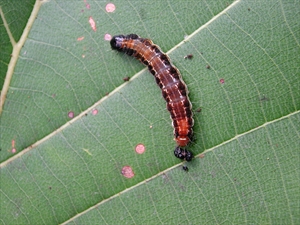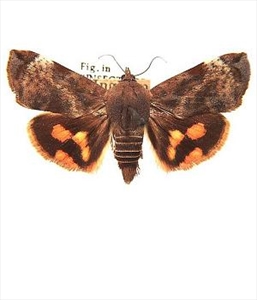Teak defoliator
Pacific Pests, Pathogens and Weeds - Online edition
Pacific Pests, Pathogens & Weeds
Teak defoliator (435)
Hyblaea purea. A moth in the Hyblaeidae.
Asia, Africa, South and Central America, the Caribbean, Oceania. It is recorded from Australia, Fiji, Papua New Guinea, Samoa, and Solomon Islands.
Teak (Tectona grandis), mangrove, Vitex, African tulip tree (Spathodea campanulata), and many more.
A major pest, especially of teak where it is grown in plantations; the larvae do the damage by defoliating the trees (hence the name).
Eggs are laid singly on the veins of young leaves, usually on the underside. There are five larval stages: the early stages are greenish with black heads, covered with silken threads, that feed on the leaf surface. Later stages up to 4.5 cm, either entirely black or dark grey to black with white lines along the sides and wide orange to ochre bands along the back, with long scattered hairs (Photos 1&2). They larvae cut folds at the leaf margin, secured them with silk, and eat within them skeletonising the leaves and often leave only the main veins (Photo 3).
When mature, the larvae descend to the ground on silken threads, construct cocoons from dry leaves or soil, and pupate. Adults have wingspans of 3-4 cm, and hindwings black with orange-yellow spots and greyish brown forewings (Photo 4). When at rest the hindwings are completely covered. Under optimum conditions the life cycle is 3 weeks.
In many parts of the world, populations occur on teak and other species at low levels throughout the year, but do not lead to outbreaks on teak. By contrast, in southern India, infestations begin on new leaf flushes in isolated tree-top patches after pre-monsoon rains, and lead to severe and rapid defoliation occurring over thousands of hectares. Similar events have been recorded elsewhere. However, the reason for these high-density population explosions occurring in some regions of the world and not others is not understood. A series of long-range dispersals on monsoonal winds is a possibility.
In India, economic loss of has been estimated at 44% of the potential volume had not the trees been defoliated. This translated to maturity at 60 years, which is usual, compared to 26 years for protected trees.
In many other parts of the world, populations occur on teak and other species at low levels throughout the years, but do not lead to outbreaks on teak although plantations have existed for many years. This is the situation in most parts of Africa and South America, although outbreaks have been recorded occasionally in Central and South America.
Look for folded margins of the leaves, larvae with characteristic broad orange or ochre stripes along the back, and adults with orange spots on black hindwings. Outbreaks are most noticeable when large numbers of mature larvae are present either raining faeces from the canopies or descending to the ground on silken threads.
NATURAL ENEMIES
A number of egg, larval and pupal parasitoids have been reported; however, neither larval nor pupal parasitism is considered to be effective, and egg parasitism only occurs at lower levels. There are two problems: (i) sudden outbreaks means that parasitoids are overwhelmed by the number of potential hosts, and (ii) by the time their numbers have increased the host populations have moved onto other areas.
Predators (insects, spiders, birds, macaques) are abundant but similarly ineffective, arriving after the infestations of the moth have caused damage. A baculovirus disease caused by a nuclear polyhedrosis virus (HpNPV) specific to the moth appears to be the most effective biocontrol agent. High mortality is reported using ultra-low volume applications.
CULTURAL CONTROL
None described.
CHEMICAL CONTROL
Bt, Bacillus thuringiensis, has been shown to be effective applied using fogging machines or aircraft in Thailand, but the high cost of application has prevented wide use. Similarly, neem (0.2% azadirachtin) has been shown to be effective in trials, but its practical application has not been reported.
____________________
When using a pesticide (or biopesticide), always wear protective clothing and follow the instructions on the product label, such as dosage, timing of application, and pre-harvest interval. Recommendations will vary with the crop and system of cultivation. Expert advice on the most appropriate pesticide to use should always be sought from local agricultural authorities.
AUTHOR Grahame Jackson
Information from CABI (2019) Hyblaea puera (teak defoliator). Crop Protection Compendium. (https://www.cabi.org/cpc/datasheet/28060); and Hyblaea puera. Wikipedia. (https://en.wikipedia.org/wiki/Hyblaea_puera). Photo 4 Hyblaea puera Cramer. 3. Systematic Names. CSIRO. Department of Agriculture & Forestry. Australian Government. (http://www.ces.csiro.au/aicn/system/c_2591.htm).
Produced with support from the Australian Centre for International Agricultural Research under project HORT/2016/185: Responding to emerging pest and disease threats to horticulture in the Pacific islands, implemented by the University of Queensland and the Secretariat of the Pacific Community.







